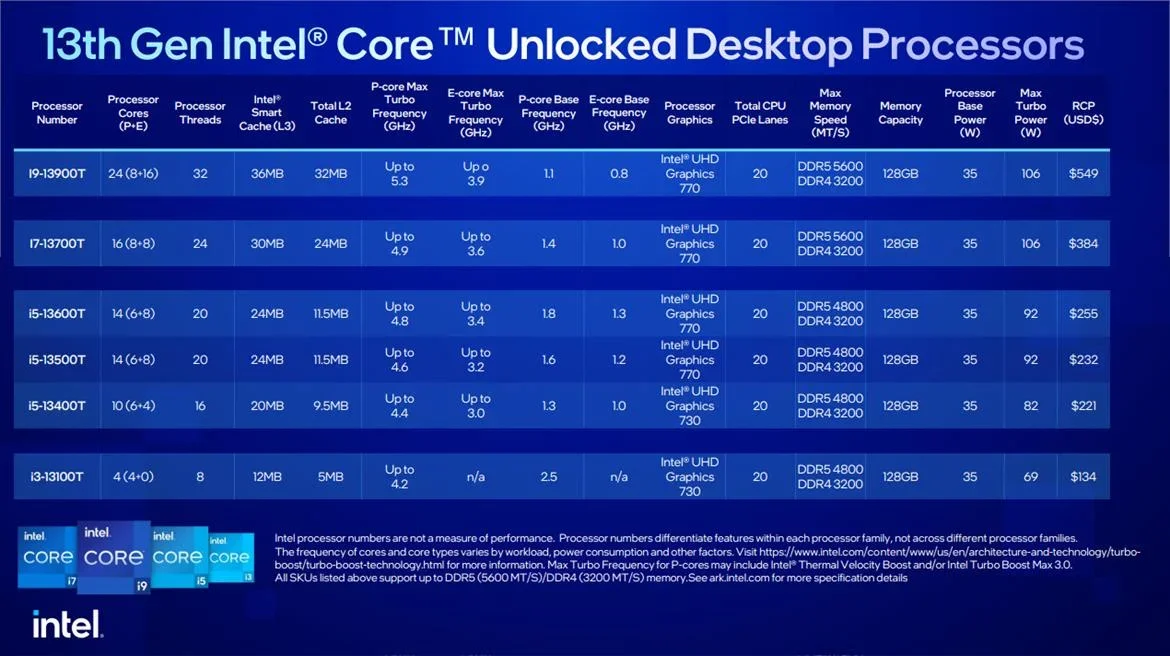
Compared to the models on the market today, all announced new processor models have a “locked” multiplier and are not aimed at users who overclock the processor. In addition, they have slightly lower operating frequencies, which indicates more stringent power management, while some of them, namely those with the English letter “F” in their names, do not have integrated graphics.

The new lineup is led by the Core i9-13900, a processor with an 8P + 16E configuration (8 cores, 16 cores, 32 threads, where P is performance and where E is efficiency) that exhibits a base operating frequency of 2.00GHz and a maximum boost frequency (maximum turbo frequency) of 5.60GHz of Where the P-cores and their corresponding operating frequencies are 1.50 GHz and 4.20 GHz for the e-core, it has 36 MB of Intel Smart Cache (L3 cache) and 32 MB of L2 cache. The base power value (core processor power) of the processor is 65 watts while the maximum power when optimized for overclocking (Max Turbo Power) is 219 watts. The variant of this processor without integrated graphics is called Core i9-13900F and has exactly the same features (except graphics as we said). In the tables below, you can also see suggested retail prices for processors for the USA with “F” models, that is, without integrated graphics, and are sold at a discount of $ 25.

The Core i7-13700 is next in terms of performance. It is a model with 8P + 8E configuration (8 P cores, 8 E cores, 24 threads) with a base operating frequency of 2.1 GHz and a maximum boost frequency (maximum turbo frequency) of up to 5.20 GHz for the P core and corresponding operating frequencies of 1.5 GHz and 4.10 GHz for the E core. It has 30MB Intel Smart Cache (L3 cache), 24MB L2 cache, and the same Max Turbo Power at 219W when the base power is 65W. Core i9-13900 integrates Intel UHD Graphics 770. The Core i7-13700F has exactly the same specifications as the Core i7-13700 but does not integrate graphics.

The Core i5-13600 features a 6P+8E configuration with six P-cores clocked between 2.7GHz and 5.00GHz and eight cores (there are a total of 20 usable threads) clocked between 2.0GHz and 3.70GHz. It has an Intel Smart Cache of 24MB while the total L2 cache is 11.5MB. For both the Intel Core i5-13600 and Core i5-13500 processors, the company hasn’t announced models without integrated graphics. The Core i5-13500 has slightly lower clock speeds of 4.80GHz for the P cores and 3.5GHz for the E cores (both processors have exactly the same core configuration and cache size). Both models have a base processor power of 65W and maximum turbo power at 154W.

The next two models in the “i5” category are the Core i5-13400 and i5-13400F. Both processors have 6 P cores and 4 E cores (6P + 4E) and come with a base operating frequency of 2.5 GHz and an enhanced operating frequency of up to 4.60 GHz for the P cores and corresponding operating frequencies of 1.8 GHz and 3.3 GHz for the E cores. It also includes 20 MB of Inte Smart Cache and a total of 9.5MB of L2 cache. Either way, the Max Turbo Power is 148W when the CPU core power is 65W. Note that the Core i5-13400 has Intel UHD Graphics 730 while the “F” model does not.

Intel also announced two Core i3 models that do not have E cores but only P cores. The models are the Core i3-13100 and i3-13100F with the latter not having graphics. These are two processors with a 4P+0E configuration (efficiency cores not included) with a base operating frequency of 3.4GHz and an enhanced operating frequency (maximum turbo frequency) of 4.5GHz. They include 12MB Intel Smart Cache (L3 cache) and 5MB Total L2 Cache while the CPU base power is 60W and 58W respectively and Max Turbo Power is 89W for both models.
In addition to the above-mentioned models, Intel also introduced some 13th generation Core i9, Core i7, Core i5 and Core i3 models belonging to the “T” series (they have the English letter T in their names) and even lower consumption (with the core power of the processor at 35 watts and Max Turbo Power which is only 106 watts, with the power management system it includes being tougher and tougher).
The company announced Core i9-13900T, Core i7-13700T, Core i5-13600T, Core i5-13500T, Core i5-13400T, and Core i3-13100T with the same number of P and E cores and cache size as above. siblings, but lower operating frequencies start at 800 MHz (!) and 1.1 GHz for the E and P cores and go up to 3.9 GHz and 5.3 GHz, respectively. In addition, the “T” series models have an unlocked multiplier.

Intel also announced four other low-power “N” series models for use in entry-level desktop and laptop computers.
As you can see in the table below, these are the Core i3-N305 and N300 models as well as the Intel Processor models N200 and N100 for laptops. The desktop models have 8 cores and 8 threads with an operating frequency between 1.25GHz and 3.8GHz while the mobile models have 4 cores and 4 threads with an operating frequency between 750MHz and 3.7-3.4GHz. Max Turbo Power for portable models is only 6W.

-
1
-
3

“Total alcohol fanatic. Coffee junkie. Amateur twitter evangelist. Wannabe zombie enthusiast.”







More Stories
Is this what the PS5 Pro will look like? (Image)
Finally, Windows 11 24H2 update significantly boosts AMD Ryzen – Windows 11 performance
Heart Surgeon Reveals The 4 Things He ‘Totally Avoids’ In His Life